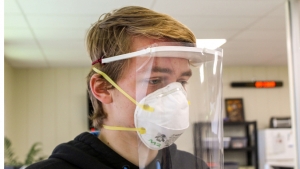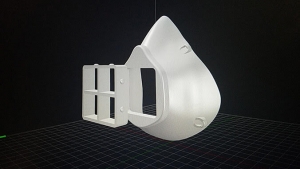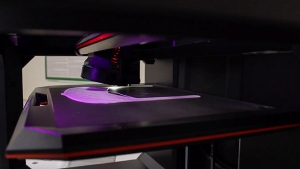Images courtesy: Hawaiʻi CC student Brenton Barcelona
Hospitals on Hawaiʻi Island are not experiencing personal protective equipment shortages during the COVID-19 pandemic so far, but a master printer and information technology specialist at the University of Hawaiʻi at Hilo are producing prototype reusable face masks and shields, just in case.
“It’s preparedness,” said UH Hilo art professor Jon Goebel, who is producing masks on the 3D printer he uses for teaching and creating art and contributing to scientific research projects. “Otherwise if we get inundated [with coronavirus patients], we haven’t done the experimenting to see if it’s possible to make protective equipment.”
Reusable face masks

Goebel is making the masks from 3D designs found on the internet. He’s working with Hilo pediatrician Craig Burger to fine tune the design.
“While we have not had a shortage of certified supplies, we started the idea in the event supplies become limited. I think living on the islands lends itself to the idea of self-independence,” says Burger, a UH Hilo alumnus who graduated in 1999 with a bachelor of science in chemistry.
“The fit test is super important,” says Goebel, a master printer and the director of UH Hilo’s printmaking program. “Our design works great, and we now have a prototype that works well. The [polylactic acid or PLA] plastic can be softened with warm water and then molded to fit.”

The reusable face masks allow for a piece of a filter, like a section of a N95 respirator, to be slipped into the box-shaped slot at the front and then discarded after use. The plastic shell is then sterilized and ready for next use. This allows for a single N95 mask to be stretched into four masks. Goebel said they could make nine reusable masks a day if needed.
He is currently on sabbatical this year and was traveling in the continental United States and abroad when the pandemic hit. He is currently sheltering in place in Indiana with family and operates the 3D printer at UH Hilo with his cell phone.
“The system was developed to print from anywhere in the world,” says Goebel. He simply uses his phone, remotely logs onto the computer at his UH Hilo office and accesses the printer program. UH Hilo professor of art Michael Marshall, chair of the Department of Art mans the printer at their offices. Goebel sets up the proper printing parameters and launches the printer.
Reusable face shields

The Department of Computer Science is also chipping in to prepare 3D printed reusable face shields.
“Hilo Medical Center still has supplies, but we want to be ready in case they run out,” said Francis Cristobal, an information technology specialist. “We are also looking into donating the face shields to the front liners like the fire department, post office and UH Hilo customer-facing staff.”
To make the reusable face shields, Cristobal and his team tested a couple of models available online and picked the best features to design their own.
“We wanted it to use the least amount of 3D print filament possible while keeping its durability,” he explained. “We want it to be printed in one piece, clearance at the front to minimize fogging, easy to sanitize and to use with easy accessible office supplies. In this case, a flat, or any, elastic, [and] PVC clear cover. The idea of the face shield is to use it with a face mask.”
UH Mānoa electrical engineering major Michael Dodge is also working in the computer lab. The Pāhoa native said the project has helped broaden his knowledge base.
“As a student this sort of life project has been a great way to put my design skills to the test. I’ve gotten countless hours of practice with 3D fabrication, 3D printing and really just everything related to that in the past few weeks,” Dodge said.
The 3D printers at UH Hilo were provided by UH System Academy of Creative Media as a part of a grant to stimulate and support visualization research and digital media initiatives on Hawaiʻi Island.
For more go to UH Hilo Stories.
—By Susan Enright

